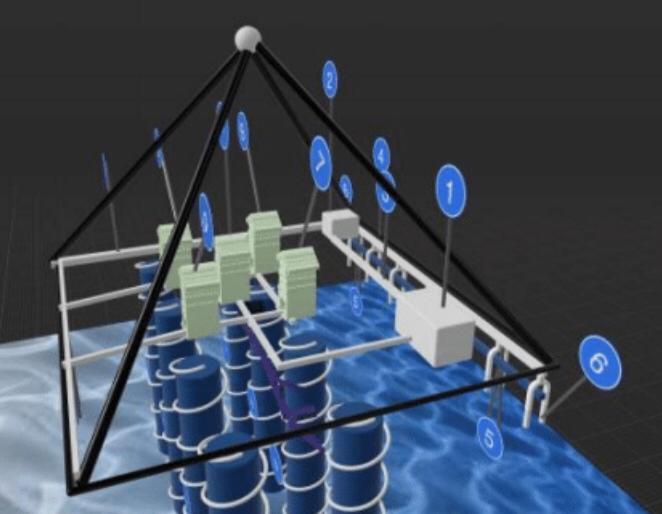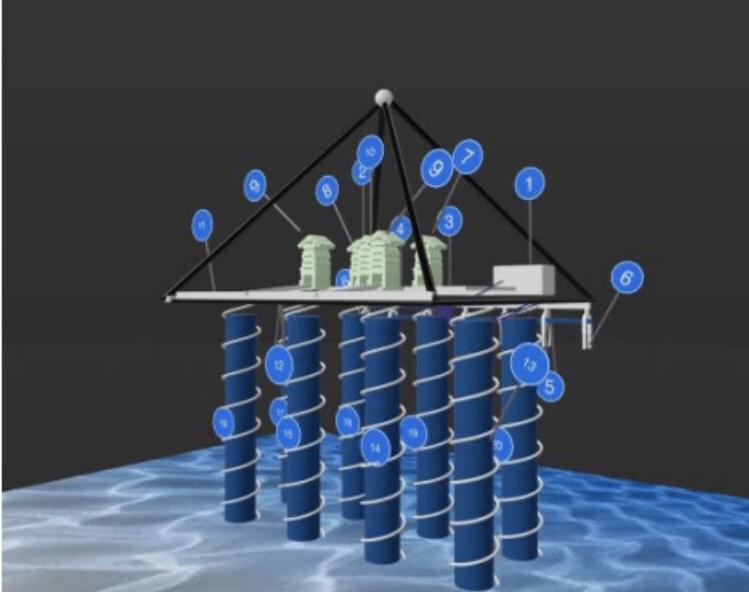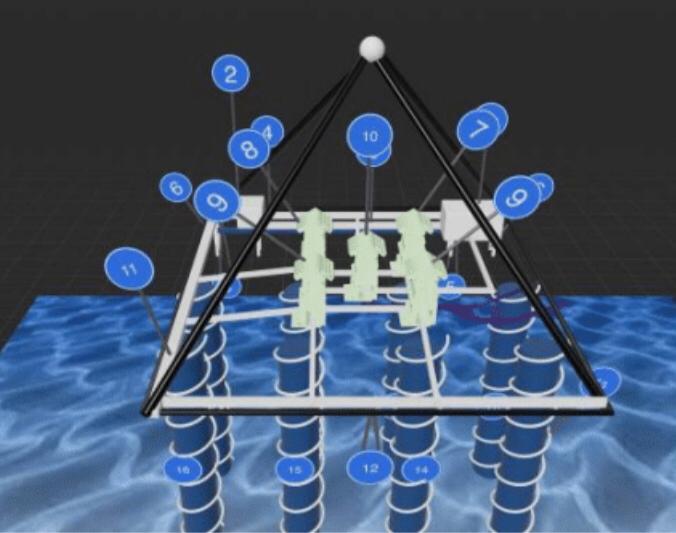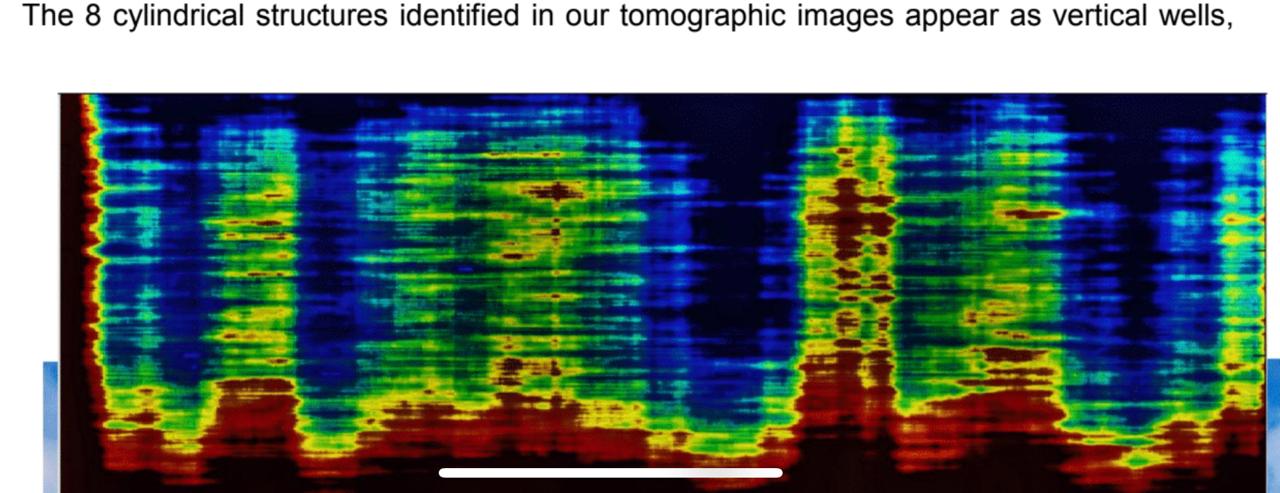Press Release Mar 23, 2025



The mystery surrounding Egypt’s Giza pyramids has deepened with the discovery of vast underground structures detected by radar.
These hidden formations extend to depths twice that of the Eiffel Tower and span an astonishing 2 kilometers. This groundbreaking revelation raises new questions about the purpose and complexity of the ancient site, further challenging our understanding of the pyramids and the civilization that built them.
Scientists have uncovered a massive underground structure near the Pyramids of Giza using advanced radar technology. Researchers Corrado Malanga from the University of Pisa and Filippo Biondi from the University of Strathclyde employed Synthetic Aperture Radar (SAR) to scan the area, revealing an extensive network stretching approximately two kilometers beneath all three pyramids.
Complex Underground System Unearthed
The findings highlight a sophisticated subterranean system. Near the base of the Khafre Pyramid, the second-largest structure on the Giza Plateau, five identical structures were identified, each featuring multiple levels linked by geometric pathways. Below these pathways, eight vertical cylindrical wells were discovered, surrounded by descending spiral pathways that plunge to depths of up to 648 meters. At the lowest level, these pathways connect to two enormous cube-shaped structures, each measuring 80 meters per side.
Rethinking the Pyramids’ Purpose
These discoveries challenge the traditional view that the pyramids were merely royal tombs. Researchers have long theorized that the underground system may have had a mechanical or energy-related function, opening new possibilities for understanding the true purpose of these ancient wonders.



https://lawsoftime.com/wp-content/uploads/2025/03/khafre.mov

Synthetic Aperture Radar Doppler Tomography Reveals Details of Undiscovered High-Resolution Internal Structure of the Great Pyramid of Giza
Download the Full Original Publication as PDF
In 2022, researchers Corrado Malanga from the University of Pisa and Filippo Biondi from the University of Strathclyde made headlines with their peer-reviewed study using Synthetic Aperture Radar (SAR) technology, uncovering previously unknown structures within the Great Pyramid of Giza.
Now, their latest research on the Pyramid of Khafre — the second-largest pyramid on the Giza Plateau — has left the scientific and archaeological communities in awe.
Using cutting-edge proprietary software that converts radar signals into phononic data, the team reconstructed a detailed 3D model of Khafre’s pyramid and the hidden structures beneath it.
What they found is nothing short of astonishing:
Five massive structures near the pyramid’s base, interconnected by geometric passageways. Each structure features five horizontal levels and sloped roofs.
Eight vertical cylindrical wells beneath these structures, hollow and surrounded by spiral pathways that plunge an incredible 648 meters into the earth.
These wells lead to two enormous underground cubes, each measuring approximately 80 meters per side, forming part of a vast system that stretches two kilometers beneath the plateau — connecting all three pyramids.
This is not just an empty void; it is a meticulously designed, functional underground complex.
Mainstream Egyptology has long maintained that the pyramids were tombs. However, these findings — combined with the pyramids’ precise use of mathematical constants like Pi, the golden ratio, and even the speed of light — challenge that narrative, opening the door to new theories about their true purpose.
https://lawsoftime.com/wp-content/uploads/2025/03/MAJOR-Discovery-under-The-Pyramids-of-Giza-CHALLENGES-Assumptions-About-The-Pyramids-Function.mp4
Video Source: https://www.youtube.com/watch?v=rWPEFoL6atc
Corrado Malanga from the University of Pisa and Filippo Biondi, a researcher specializing in radar and remote sensing at the University of Strathclyde, published groundbreaking peer-reviewed research in 2022 through MDPI. Their study, titled “Synthetic Aperture Radar Doppler Tomography Reveals Details of Undiscovered High-Resolution Internal Structure of the Great Pyramid of Giza,” utilized Synthetic Aperture Radar (SAR) data alongside proprietary software developed by Biondi. This innovative software transforms radar signals into phononic information, enabling the detection of millimetric vibrations and revealing underground structures invisible to traditional methods. Their work uncovered previously unknown internal features of the Great Pyramid.
Building on their expertise in non-invasive pyramid exploration, the team released a press statement Saturday, March 15th 2025, detailing their latest findings on the Pyramid of Khafre, the second-largest pyramid on the Giza Plateau. The results are nothing short of extraordinary.
By analyzing dozens of tomographic SAR images taken from various angles, the researchers reconstructed a 3D model of the Khafre Pyramid’s interior and the structures deep beneath the plateau. Near the pyramid’s base, they identified five identical structures connected by geometric pathways, each containing five horizontal levels and a sloping roof. Below these structures lie eight vertical cylindrical wells, hollow inside and encircled by descending spiral pathways. These wells, arranged in two parallel rows from north to south, extend to a depth of 648 meters, where they converge into two massive cubic structures, each measuring approximately 80 meters per side. The entire underground system spans roughly two kilometers and extends beneath all three pyramids of the Giza complex.
Mainstream Egyptology maintains that the Giza pyramids were built around 2500 BC as tombs for the pharaohs Khufu, Khafre, and Menkaure, constructed using ramps, sledges, and levers. However, the precise mathematical features of the pyramids—such as the use of Pi, the golden ratio, and even the speed of light—coupled with insights from modern architects, suggest that this traditional narrative may be incomplete.
The recent SAR data reveals what appears to be a mechanical or functional system beneath the pyramids, a concept that has been theorized before. Nikola Tesla speculated that the pyramids could harness Earth’s natural frequencies, an idea that may have influenced his experiments in wireless energy transmission and scalar waves. In The Giza Power Plant, Christopher Dunn proposed that the Great Pyramid functioned as a power-generating machine, using resonant and acoustic forces to convert mechanical stress into electricity. Similarly, in The Giza Death Star, Joseph Farrell suggested that the Great Pyramid was a weapon of mass destruction, employing a form of “paleophysics” to focus energy as a scalar weapon.
The cylindrical wells discovered in the Khafre Pyramid could serve as conduits for energy or sound waves, while the cubic structures might act as energy storage or stabilization units, resembling components of a large-scale generator or weapon. The detection of vibrations within the pyramid’s internal structures further supports these theories.
The Khafre Project team hopes to plan an excavation to explore this underground system further. However, given the challenges of obtaining approval for such endeavors, this next step may prove difficult. Nevertheless, their findings continue to challenge conventional understanding and open new avenues for exploring the true purpose of these ancient wonders.

Nikola Tesla, the renowned inventor, electrical engineer, and futurist, is often associated with a wide range of theories and ideas that extend beyond his well-documented contributions to science and technology. Among these are his beliefs and speculations about ancient structures, including the Pyramids of Giza, particularly the Khafre Pyramid (also known as the Pyramid of Chephren). While Tesla never published a comprehensive study on the pyramids, his writings, interviews, and personal notes suggest that he held a deep fascination with these ancient monuments and believed they were more than just tombs for pharaohs. His ideas about the pyramids were intertwined with his broader interests in energy, vibration, and the mysteries of the natural world.
Tesla’s Fascination with the Pyramids
Tesla’s interest in the Pyramids of Giza was rooted in his belief that ancient civilizations possessed advanced knowledge that had been lost over time. He speculated that the pyramids were not merely architectural marvels but also sophisticated machines or energy-generating devices. Tesla was particularly intrigued by the precision and alignment of the pyramids, which he believed hinted at a deeper understanding of mathematics, astronomy, and physics. He often drew parallels between his own work with electricity and wireless energy transmission and the potential functions of the pyramids.
The Khafre Pyramid and Energy
The Khafre Pyramid, the second-largest of the three main pyramids at Giza, is often considered the most visually striking due to the remnants of its original limestone casing at the apex. Tesla believed that the pyramid’s design and materials were intentionally chosen to harness and amplify energy. He speculated that the pyramid’s geometry and alignment with the Earth’s magnetic fields allowed it to function as a resonant structure capable of capturing and transmitting energy.
Tesla’s experiments with electromagnetic waves and resonance led him to theorize that the pyramids could have been used as power plants or energy transmitters. He suggested that the pyramid’s shape, combined with its placement on the Earth’s surface, allowed it to tap into natural energy sources, such as telluric currents (electrical currents that flow through the Earth) or cosmic energy. Tesla’s concept of wireless energy transmission, which he demonstrated in his Wardenclyffe Tower project, bore similarities to his ideas about the pyramids’ potential function.
The Role of Materials and Construction
Tesla was particularly interested in the materials used in the construction of the pyramids. The Khafre Pyramid, like the other Giza pyramids, was built using massive limestone and granite blocks. Tesla believed that these materials were chosen not only for their durability but also for their piezoelectric properties. Piezoelectric materials generate an electric charge in response to mechanical stress, and Tesla speculated that the pyramids’ construction could have utilized this phenomenon to convert vibrations or pressure into electrical energy.
Additionally, Tesla noted the precision with which the pyramids were built. The alignment of the pyramids with the cardinal points of the compass and their precise dimensions suggested to him that the builders had a sophisticated understanding of geometry and geophysics. He believed that this precision was not accidental but was integral to the pyramids’ function as energy devices.
Alignment with Cosmic Forces
Tesla’s theories about the pyramids also extended to their alignment with cosmic forces. He believed that the pyramids were designed to interact with the Earth’s magnetic field and other natural energies. The Khafre Pyramid, like the Great Pyramid of Giza, is aligned with remarkable accuracy to true north. Tesla speculated that this alignment allowed the pyramid to act as a conduit for cosmic energy, channeling it for practical or spiritual purposes.
Tesla’s interest in cosmic energy was closely tied to his work on wireless transmission and his belief in the existence of a universal energy source. He often spoke of the “aether,” a hypothetical medium that permeates the universe and transmits energy. Tesla believed that the pyramids could have been designed to interact with this energy field.
Spiritual and Mystical Dimensions
In addition to his scientific theories, Tesla also entertained more mystical ideas about the pyramids. He believed that ancient civilizations had access to knowledge that transcended the material world and that the pyramids were imbued with spiritual significance. Tesla’s writings occasionally touched on themes of harmony, vibration, and the interconnectedness of all things, which he saw reflected in the design and purpose of the pyramids.
Tesla speculated that the pyramids could have been used for purposes beyond energy generation, such as communication with other dimensions or as tools for spiritual enlightenment. These ideas reflect Tesla’s holistic view of the universe and his belief in the unity of science and spirituality.
Legacy and Influence
Tesla’s ideas about the pyramids have inspired a wide range of alternative theories and speculations. Tesla’s theories have contributed to a broader interest in the potential technological and scientific knowledge of ancient civilizations. His belief in the pyramids as energy devices has influenced modern researchers and enthusiasts who explore the intersection of ancient architecture and advanced physics.
1899 Interview with Tesla >>
Nikola Tesla’s beliefs about the Khafre Pyramid and the Pyramids of Giza were shaped by his unique perspective as a scientist, inventor, and visionary. He saw the pyramids not merely as relics of the past but as evidence of a lost civilization’s advanced understanding of energy, geometry, and the natural world. Tesla’s fascination with the pyramids continues to inspire exploration and debate, bridging the gap between ancient history and modern science.
